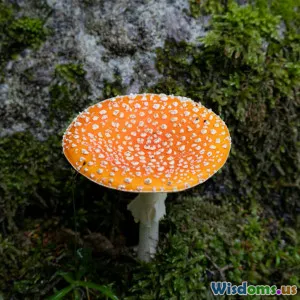
Unexpected Dangers of Foraging Wild Mushrooms and Their Signs
8 min read Discover the hidden risks of wild mushroom foraging and how to spot danger before it's too late. (0 Reviews)
Unexpected Dangers of Foraging Wild Mushrooms and Their Signs
Foraging wild mushrooms is an enthralling adventure that connects us deeply with nature. The rich diversity of fungi across forests and fields offers culinary delights and medicinal benefits. However, lurking beneath this allure are hidden dangers that every mushroom enthusiast must carefully navigate. Mistaking a toxic mushroom for an edible one can result in severe poisoning, permanent organ damage, or even death. This article explores the unexpected hazards associated with wild mushroom foraging and equips you with vital signs to distinguish safe picks from lethal impostors.
The Rising Popularity of Wild Mushroom Foraging
In recent years, mushroom foraging has surged in popularity, fueled by TV shows, culinary trends, and a growing interest in survival skills and sustainable living. According to a 2020 study published in the journal Mycology, mushroom hunting is now a common recreational activity in regions like North America and Europe, where amateurs and experts alike scour woodlands for prized finds like morels, chanterelles, and porcini.
However, this enthusiasm can be a double-edged sword. Inexperience combined with the sheer variety of fungi—over 10,000 species in North America alone, with about 50 to 100 considered dangerously toxic—creates a risky environment for novices.
Unexpected Dangers Lurking in Wild Mushrooms
1. Misidentification: The Most Common Fatal Mistake
Perhaps the most insidious risk of foraging lies in the potential for misidentification. Many toxic mushrooms closely resemble edible ones. For instance, the deadly Amanita phalloides (death cap) can be confused with edible straw mushrooms or puffballs in early growth stages. Consuming even a small amount of death cap toxins can cause acute liver and kidney failure.
Example: In 2019, a cluster of poisoning cases in California was attributed to misidentified Amanita mushrooms, leading to numerous hospitalizations and one fatality.
2. Delayed Symptoms Leading to Fatal Outcomes
Some mushroom toxins have a latent period where no symptoms manifest, typically 6-24 hours post ingestion. This delay is perilous because individuals may underestimate the severity, delaying crucial medical intervention.
For example, Galerina marginata, a highly poisonous mushroom, produces amatoxins similar to the death cap. Initial symptoms may appear as mild gastrointestinal distress, only to escalate into life-threatening organ dysfunction days later.
3. Allergic Reactions and Toxicities Beyond Mushrooms Themselves
Unexpected allergic reactions can occur with wild mushrooms, even if non-toxic. Additionally, some wild mushrooms can absorb heavy metals like lead or mercury from polluted environments, posing contamination risks.
4. Environmental Hazards While Foraging
Foraging also exposes seekers to environmental dangers—poisonous plants, venomous animals, or risky terrain, especially in remote locations where cell service is limited. Focusing solely on mushrooms can distract one from surrounding hazards.
Recognizing the Warning Signs of Dangerous Mushrooms
Successful and safe mushroom foraging hinges on keen observation and reliable identification protocols. Here are key signs that indicate a mushroom may be toxic:
Color and Appearance
- Bright, alarming colors: Many poisonous species display vivid reds, oranges, or whites that signify toxins.
- Warts or Scales on Caps: Toxic Amanita species often have distinctive white warts on their greenish/brownish caps.
- Gills Color: White gills under the cap, especially if they don’t change with age, can indicate danger. In contrast, many edible species have pink or brown gills.
Odor
- Mushrooms with an unpleasant or chemical-like smell often signal toxicity. For instance, Clitocybe species may emit a foul, sour odor.
Habitat and Growth Patterns
- Mushrooms growing close to industrial or polluted sites risk contamination.
- Species that grow in clusters or fairy rings should be approached carefully. For example, the deadly Inocybe grows in rings.
Presence of a Volva and Ring
- The volva, a cup-like structure at the mushroom base, and a ring on the stalk are hallmark features of many poisonous Amanita mushrooms.
- Digging up mushrooms completely to inspect these features is essential.
Bruising and Color Changes
- Toxic varieties sometimes change color when bruised or cut (e.g., Boletus satanas stains blue).
Best Practices to Ensure Safe Foraging
1. Never Rely on One Feature Alone
Mycologists stress that no single characteristic suffices for safe identification. Combining cap shape, spore print color, gill attachment, and habitat data forms a safer profile.
2. Use Multiple Trusted Guides and Resources
Certain field guides such as "Mushrooms Demystified" by David Arora and apps verified by mycological societies offer critical support. Local mushroom clubs and workshops provide hands-on learning.
3. When in Doubt, Throw It Out
The old adage is sound: refuse harvest if there's any uncertainty. Edible mushrooms often have similar, safer alternatives.
4. Start with Easy, High-Safety Species
Learn to recognize foolproof mushrooms like morels or chanterelles before moving on to complex or dangerous groups.
5. Always Harvest Mushrooms Whole
Digging carefully to see the base helps detect a volva or root-like mycelium.
Real-World Insights and Stories
The story of Nicholas Evans, an accident survivor who unknowingly ate a cluster of Galerina mushrooms in 2016, illustrates how even one small mistake can be deadly. His experience catalyzed an awareness campaign sponsored by the North American Mycological Association that emphasizes recognizing telltale signs before consuming wild fungi.
Medical research from the Mayo Clinic estimates that 90% of severe mushroom poisoning cases involve amatoxin-containing species. Prompt diagnosis and supportive treatment can significantly reduce fatality risks but depend largely on early recognition.
Conclusion
Foraging wild mushrooms is a fascinating skill that enriches survival abilities and outdoor adventures. However, beneath the excitement reside hidden threats primarily from toxic look-alikes, delayed symptoms, and environmental dangers. Educating yourself on key warning signs, applying rigorous identification methods, and respecting fungi’s biological complexity are non-negotiable steps to a safe and rewarding experience.
By approaching mushroom hunting with authoritative knowledge and caution, you transform what can be a perilous gamble into a wise and enriching practice. Remember, every mushroom tells a story—learn to read it well before you harvest.
Stay curious, stay safe, and savor the wild responsibly.
Rate the Post
User Reviews
Popular Posts





















